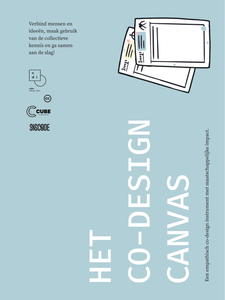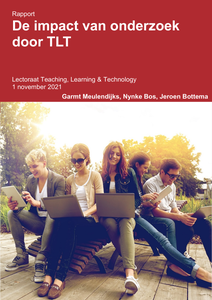Het Co-Design Canvas is een instrument om samenwerkingen rondom maatschappelijke uitdagingen met verschillende betrokkenen open en transparant te starten, plannen, uitvoeren en evalueren. Het biedt een hulpmiddel aan overheden, burgers, bedrijven, non-profitorganisaties, kennisinstellingen en andere belanghebbenden om helder te kunnen communiceren en samenwerken. Het maakt verschillen in belangen, kennis, ervaring en machtsverhoudingen inzichtelijk, staat vanaf het begin stil bij gewenste positieve impact en concrete resultaten en zorgt ervoor dat ieders stem echt gehoord wordt.
MULTIFILE

Deze casestudie geeft inzicht in verschillende soorten kennis die kenmerkend zijn voor applied design research. Er wordt onderscheid gemaakt tussen kennis over de huidige situatie, over wenselijke alternatieven en over effectieve oplossingen om daar te komen. Ofwel, kennis hoe het is, kennis over hoe het kan zijn en kennis over hoe het zal zijn als we effectieve oplossingen toepassen. Elk van deze soorten kennis heeft andere kwaliteitscriteria.
DOCUMENT

Deze publicatie richt zich vooral op het concept Design Based Research,gezien vanuit het perspectief van de bijna 40 lectoren die de hogeschool rijk is. Dit lectoratenoverzicht kan worden beschouwd als een atlas of reisgids waarmee de lezer een route kan afleggen langs de verschillende lectoraten. De lectoraten die actief zijn op het gebied van de Service Economy worden beschreven in hoofdstuk 2. De lectoraten die actief zijn op het gebied van Vitale Regio worden beschreven in hoofdstuk 3. De lectoraten die actief zijn op het gebied van Smart Sustainable Industries worden beschreven in hoofdstuk 4. De lectoraten die actief zijn op het gebied van de hogeschoolbrede thema’s Design Based Education en Research worden beschreven in hoofdstuk 5. Tenslotte wordt er in hoofdstuk 6 een eerste aanzet gedaan om één of meer verbindende thema’s of werkwijzen te ontdekken in de aanpak van de verschillende lectoraten. Het is niet de bedoeling van deze publicatie om een definitief antwoord te geven op de vraag wat NHL Stenden precies bedoelt met het concept Design Based Research. Het doel van deze publicatie is wel om een indruk te krijgen van wat er allemaal gebeurt binnnen de lectoraten van NHL Stenden, en om nieuwsgierig te worden naar meer.
DOCUMENT

Het lectoraat Teaching, Learning & Technology onderzoekt de didactische inzet van technologie in leerprocessen. Hierbij kijkt het lectoraat naar thema’s als flexibilisering, gepersonaliseerd leren, activerende didactiek en de effecten van de inzet van technologie in de onderwijspraktijk en dan met name het hoger beroepsonderwijs. Wat tot op heden nog niet was onderzocht was of eerder uitgevoerd onderzoek een aantoonbare impact heeft gehad op de onderwijspraktijk. Dit onderzoek is de eerste fase in het inzichtelijk maken van de impact van onderzoek dat het lectoraat Teaching, Learning & Technology (TLT) van hogeschool Inholland heeft uitgevoerd. Er is daarbij gekeken naar onderzoek in de periode 2010 – 2021. De doelstelling is weer te geven hoe in eerder onderzoek beïnvloedbare impactfactoren zijn vormgegeven. Op basis van deze beschrijving kunnen wellicht aanbevelingen worden gedaan aan het lectoraat waarmee de impact van door hen uitgevoerd onderzoek in relatie tot deze factoren, vergroot kan worden. De onderzoeksvraag is: Hoe beschrijven belanghebbenden de impact van door het lectoraat Teaching, Learning & Technology uitgevoerd onderzoek in relatie tot de beïnvloedbare impactfactoren aangaande het onderzoek, de disseminatie en de (ervaren) gebruikswaarde? Voor het beantwoorden van deze onderzoeksvraag maakten we gebruik van een convergent mixed methods design, waarbij een nieuw conceptueel model als basis diende voor de analyse van data uit het praktijkonderzoek. Daarbij hebben we drie typen data verzameld, namelijk een kwalitatieve documentanalyse (N=31), een survey (N=6) en semi-gestructureerde interviews met participanten van de survey (N=4). Uit het onderzoek bleek dat belanghebbenden vooral de onderzoeker aanwijzen als primaire bron van impact. Impact begint en eindigt bij de onderzoeker, vooral in de mate waarin die zich inzet om het onderzoek relevant te maken en te laten aansluiten op vragen vanuit de onderwijspraktijk. Ten aanzien van de wijze waarop impact in toekomstig onderzoek kan worden bewerkstelligd, benoemen we een aantal aandachtspunten. Deze aanbevelingen zijn vooral gericht op de wijze waarop onderzoekers van het lectoraat gestructureerd aandacht kunnen besteden aan de vormgeving van de samenwerking en aan het concreet in beeld brengen van verwachtingen en beoogde impact in een vroegtijdig stadium.
DOCUMENT

We need look no further than the use of email communication, mobile phones and cars to understand that technology has wide-ranging social consequences. What is more, designers are plainly not always aware of the social consequences of technology, despite practicing user-centred design. Email, for instance, was developed as an efficient mode of communication between two actors. As we all know, the introduction of email has fundamentally changed traditional business and office practices. These side effects were not identified until long after email was introduced. During recent years, designers have grown increasingly interested in these social aspects. Modern information technology, in particular, creates extensive possibilities to influence social behaviour. Persuasive technology has been developed to increase, e.g., environmental friendliness. Once a designer aims at defined social changes, the consequences of technology for practices become a responsibility, too. The present research is aimed at providing tools and methods to anticipate social consequences at an earlier stage of the design process. These consequences of technologies in social environments will be called social impacts. In order to be a meaningful concept for designers the characteristics of a particular technology that are responsible for social impacts must be identified. Social consequences of technologies have not been observed very thoroughly from a user-centred design point of view. Therefore, this thesis is aimed, not only at gaining knowledge about social impact, but also translating these insights into workable instruments for designers. This leads to the following research questions:1. What relations can be identified between social impacts and characteristics oftechnologies?2. How can a designer anticipate social impact?3. How can social impact be managed in design environments?
DOCUMENT
Het lectoraat Co-Design van Hogeschool Utrecht doet met een systemisch-inclusieve ontwerpende aanpak praktijkgericht onderzoek, om complexe maatschappelijke vraagstukken te helpen oplossen. Binnen die onderzoeken stellen we vragen over het ontwerpproces en de mensen die daarbij betrokken zijn. Hoe kun je goed co-designen in de weerbarstige werkelijkheid? Wat kan helpen in die ontwerpende aanpak? Hoe kunnen mensen die niet zijn opgeleid als ontwerpers volwaardig meedoen in het ontwerpproces, en wat hebben zij daarvoor nodig aan ontwerpend vermogen? De kennis over ontwerpend vermogen die we de afgelopen vier jaar hebben opgedaan, delen we in dit boekje. We hebben dat proces getekend en beschreven als een reisverhaal van Co, die ons meeneemt op een boot over een rivier, door stroomversnellingen en langs landschappen. Met bijdragen van: Marry Bassa, Anita Cremers, Tanja Enninga, Anita van Essen, Christa van Gessel, Berit Godfroij, Joep Kuijper, Remko van der Lugt, Caroline Maessen, Lenny van Onselen, Dirk Ploos van Amstel, Karlijn van Ramshorst, Carolijn Schrijver, Fenne Verhoeven, Danielle Vossebeld, Rosa de Vries
DOCUMENT

Social issues are becoming increasingly pressing. From dementia to climate change to corona; we as people, citizens, residents and city users - through our own experience or otherwise - have a sense of them. However, truly understanding and addressing these issues is difficult because there is no single owner. Everything is related, intertwined and also changing. Getting an overview and deciding together on necessary steps proves difficult. Complex issues thus become orphaned. Design and more specifically co-design - creative collaboration with others - is increasingly seen as a possible approach to these such issues and collaborations because it can deal with complexity and uncertainty, is optimistic and investigative in nature. With a co-design approach, we can find a shared desire and with that we connect with each other. By then searching together for mechanisms that can lead to the desired values, we gain insights on how to tilt a problematic situation. That enables us to imagine alternative futures. These help us on our way to a better, greener and more social world and social change.
DOCUMENT

Societal challenges are urgent and affect everyone, including politicians, citizens, government officials, business professionals, NGOs, designers and researchers. Understanding and addressing these challenges is difficult because no single stakeholder or organisation is solely responsible. Everything is interconnected and constantly changing, resulting in challenges being neglected and stakeholders being unable or unwilling to make important decisions. The Co-Design Canvas is a practical and user-friendly tool that supports flexible planning, conducting, and evaluating of co-design processes for multi-stakeholder coalitions and facilitators. It encourages coalitions to discuss and consider eight co-design variables. The accompanying manual helps people find common ground and align their perspectives. - Discover how to facilitate open and transparent dialogue. - A useful tool for initiating, planning, conducting and assessing collaborations. - Learn about inclusivity and effective collaboration in addressing societal challenges. The book can be ordered at : https://www.bispublishers.com/co-design-canvas.html
DOCUMENT
Knowledge from academic design research projects does not always help design professionals to actually strengthen their work. Based on a multi-case study, this paper describes how researchers view the impact of their design research projects on design practice and what they do to achieve this. Even in projects where impact on design practice is a stated ambition, several challenges can stand in the way, such as a lack of funding opportunities and unclarity on the needs of design practice. The paper provides tips for researchers and funding parties who want to inform design practice by research, including tips to operationalize design practice roles.
LINK
Design en onderzoek zijn twee kennisgebieden die elk hun eigen tradities, methoden, standaarden en praktijken hebben. Deze twee werelden lijken behoorlijk gescheiden, waarbij onderzoekers onderzoeken wat er is en ontwerpers visualiseren wat er zou kunnen zijn. Dit boek slaat een brug tussen beide werelden door te laten zien hoe design en onderzoek geïntegreerd kunnen worden om een nieuw kennisveld te ontwikkelen. Dit boek bevat 22 inspirerende beschouwingen die laten zien hoe de unieke kwaliteiten van onderzoek (gericht op het bestuderen van het heden) en ontwerp (gericht op het ontwikkelen van de toekomst) gecombineerd kunnen worden. Dit boek laat zien dat de transdisciplinaire aanpak toepasbaar is in een veelheid van sectoren, variërend van gezondheidszorg, stedelijke planning, circulaire economie en de voedingsindustrie. Het boek bestaat uit vijf delen en biedt een scala aan illustratieve voorbeelden, ervaringen, methoden en interpretaties. Samen vormen ze het kenmerk van een mozaïek, waarbij elk stukje een deel van het complete plaatje bijdraagt en alle stukjes samen een veelzijdig perspectief bieden op wat toegepast ontwerponderzoek is, hoe het wordt geïmplementeerd en wat de lezer ervan kan verwachten.
DOCUMENT
